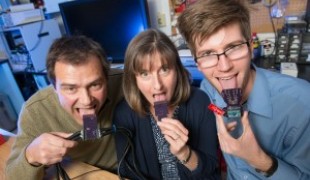- 9909
- 639
- 19
- 14
- 0
- Help Ukraine
About the solution
While still in high school, Quentin conceived the Deaf Tab, an electronic device that detects sound as soon as an alarm starts and sends a visual or a vibrant message, to help ensure deaf people are aware of it. The device enables deaf people to find a certain autonomy at home or at work.
Quentin, the leader of the project, conceived, with the help of his friends, Deaf tab, the device that detects every sound alarm in a house such as a fire alarm, the doorbell or the baby phone.
His creation allowed him to be a finalist on several competitions, such as the Google Science Fair, even though Quentin does not want to be an entrepreneur. He wants to commercialise his invention at low cost so that a maximum number of people can use it. The device could be built by anyone, since the different parts are easy to assemble. The device itself costs approximately 57,50 € and the transmitter costs about 8 €. Quentin is currently looking for an investor to support his plan.
Adapted from: https://bit.ly/2i6kTMU
这些解决方案不应包括使用药物,化学品或生物制品(包括食品);创伤性设备;冒犯性的,商业或内在危险的内容。该解决方案未经医学验证。请谨慎进行!如果您有任何疑问,请咨询健康专家。
DISCLAIMER: This story was written by someone who is not the author of the solution, therefore please be advised that, although it was written with the utmost respect for the innovation and the innovator, there can be some incorrect statements. If you find any errors please contact the patient Innovation team via info@patient-innovation.com
-
-
393
-
0
-
5273

Dad combines devices to help disabled child use computers
COMMUNICATION: Communicating, whether by speaking, listening, or other means
Playing
Cerebral Palsy
Assistive Technology access
AI algorithm
Restoring mobility
Promoting self-management
Managing Neurological Disorders
Promoting inclusivity and social integration
Improving Speech and Communication
Preventing (Vaccination, Protection, Falls, Research/Mapping)
Raise awareness
Child and Adolescent Psychiatry
General and Family Medicine
Neurology
Pediatrics
Canada
-
-
-
395
-
0
-
4483

Team creates device that allows "listening" through tongue
COMMUNICATION: Communicating, whether by speaking, listening, or other means
Hearing Disorders
Assistive Technology access
AI algorithm
Hearing loss or ringing in the ears (tinnitus)
Regaining sensory function
Promoting inclusivity and social integration
Improving Speech and Communication
Neurology
Otorhinolaryngology
United States
-
-
-
604
-
0
-
8874

Man who had a concussion creates computer interface to get brain data
COMMUNICATION: Communicating, whether by speaking, listening, or other means
CAREGIVING
Rubgy
Brain Injury (Abscess, Brain Barrier Defect, Brain Contusion, Brain Hemorrhage, Brain Edema)
Cervical spinal cord injury/Tetraplegia
Assistive Technology access
App (Including when connected with wearable)
Difficulty coordinating movements
Muscle weakness
Memory loss
Sleep disturbances
Headaches
Dizziness or lightheadedness
Managing Neurological Disorders
Preventing (Vaccination, Protection, Falls, Research/Mapping)
Neurology
Sports Medicine
United States
-
 zh
zh